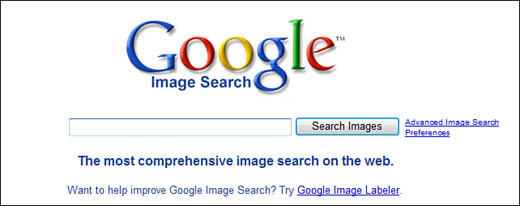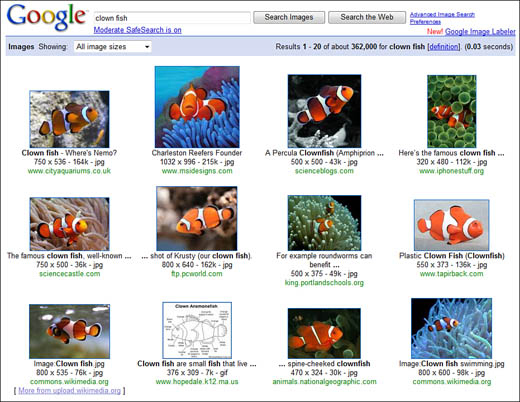There are two ways to access Google Image Search, shown in Figure 24.1. You can click the Images link on any Google search page, or you can go directly to images.google.com. (Google Image Search results also appear as part of Google’s universal search results when you search from the main search box.)
For most users, searching Google Image Search is as easy as entering your query into the search box and clicking the Search Images button. Nothing to it.
You can use any of Google’s advanced search operators within your query. Of particular use is the filetype: operator, which you can use to limit your search to JPG or GIF image files.
If you want to fine-tune your image search, the best way to do so is to use the Advanced Search page. When you click the Advanced Image Search link on the main Image Search page, you see the form shown in Figure 24.2. From here you can fine-tune your search in a number of ways:
-
Find results. Narrow your search by searching for all the words, the exact phrase, any of the words, or pictures not related to the words.
Note
Learn more about advanced search operators in Chapter 6, “Getting the Most Out of Google Search.”
-
Content types. Search only for images that contain news content, faces, or any content.
-
Size. Search only for images that are small, medium, large, or extra large.
-
Filetypes. Search only for JPG, GIF, PNG, or BMP format files.
-
Coloration. Search only for black-and-white, grayscale, or full-color images, or search for any color.
-
Domain. Search only for images within a specified domain or website.
-
SafeSearch. Apply moderate, strict, or no filtering to the image search results.
The Advanced Image Search page is great if you’re looking for images of a particular file type—for example, if you’re looking only for JPG images. It’s also good if you want to look for portraits or other pictures of people by using the Content Types option. In addition, this page helps you find larger or higher-resolution pictures for print purposes (both of which are likely to be of a larger file size) or smaller or lower-resolution pictures for Web use (both of which are likely to be of a smaller file size).
This begs the question of how small is small. Or how large is large, for that matter. The answers to these questions are detailed in Table 24.1.
When you click the Search Images button, Google returns the first page of results. As you can see in Figure 24.3, the matching images are displayed in a grid of thumbnail pictures, ranked in terms of relevance.
For each thumbnail image, Google lists an image caption, the size of the image (in both pixels and kilobytes), the file type, and the host website. To view any image, all you have to do is click the thumbnail.
Tip
If you’d rather limit the results to images of a particular size (small, medium, large, or extra large), pull down the Images Showing: list at the top of the page and make the appropriate selection.
When you click a thumbnail image, the original page is displayed in a frame at the bottom of the next page, as shown in Figure 24.4. At the top of the page is the Google Images frame, which includes the image thumbnail, information about the image, and a few important links:
-
To view the host page without the Google frame, click the Remove Frame link.
-
To view the picture full size, click the See Full-Size Image link. (Not available if you’ve selected to display small images only.)
-
To return to your search results, click the Image Results link.
Almost any image you find on the Web can be saved to your hard disk or printed. (Unless the page designer has implemented some form of copy protection for the image, that is.) Saving and printing images is a function of your web browser, but here’s how to do it in Internet Explorer.
Note
Some sites use special code to prevent users from downloading images. If you right-click the image and see a message to this effect, you can’t save that particular image to your hard disk.
To save an image to your hard disk, right-click the picture and select Save. When the Save As dialog box appears, select a location for the picture, and then click the Save button.
Caution
Commercial use of copyrighted images is prohibited, so be careful how you use the pictures you find with Google Image Search.
To print a picture (without printing the surrounding web page), right-click the image and select Print. When the Print dialog box appears, click the Print button.
One of the bad things about searching the Web for pictures is that, depending on your query, you’re likely to stumble across a few adult-oriented pictures in your search results. Assuming that you don’t want (or don’t want your kids) to see these dirty pictures, Google enables its moderate SafeSearch content filter by default when you use Google Image Search. (Moderate SafeSearch filtering blocks the display of questionable images only, not text.)
If you’d prefer to view your search results unfiltered, you have two options:
-
From any search results page, click the Moderate SafeSearch Is On link. This takes you to the Preferences page; check the Do Not Filter My Search Results option, and then click the Save Preferences button.
-
From the main Google Image Search page, click the Preferences link. When the Preferences page appears, check the Do Not Filter My Search Results option, and then click the Save Preferences button.
If you’re an artist or photographer, you might find that your copyrighted images appear in Google Image Search. This might be okay with you, or it might not. If you’d prefer that your images not be displayed in Google Image Search, you can request that Google remove them.
Tip
If you want to help Google improve the accuracy of its Image Search results, click the Google Image Labeler link at the top of any Image Search page. Google Image Labeler is a voluntary program where you and an automatically selected online partner view a set of images and enter as many labels as possible for each image. Your responses are used to categorize the images that Google shows you.
To remove a copyrighted image from Google Image Search, you have to add a special text file to the root directory of your website. This file should be labeled robots.txt, and it needs to include specific information about the images you want to protect.
If you want to remove a specific image file from the Google search index, add the following lines to the robots.txt file:
User-agent: Googlebot-Image
Disallow: /subdirectory/file.jpg
You replace subdirectory with the name of the subdirectory where the image file is located, and you replace file.jpg with the name and extension of the file you want to protect.
Alternatively, you can instruct Google to remove all images on your site from the Google search index. In this instance, you want to add the following lines to the robots.txt file:
User-agent: Googlebot-Image<
Disallow: /
When the GoogleBot spider crawls your site, it automatically reads the contents of the robots.txt file for instructions. If your site includes a robots.txt file, the spider will follow the instructions you specify, and not add the image file(s) you noted.





